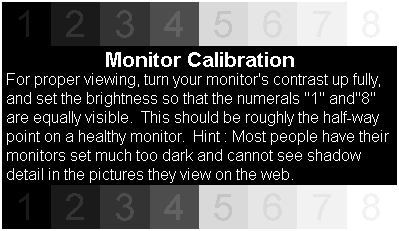|
|
Monitor Calibration
  At the left is a simple monitor calibration target. Its sole purpose is to check the brightness adjustment on your monitor to ensure that you can see the detail in the shadow regions of images. The most important part of the target is the numeral "1" on the lefthand side. If you can't clearly read this number, then you've got your brightness turned down too low, and you won't be able to see a lot of the details in the pictures displayed on this site. The "1" should be approximately as readable as the "8" in a normally lit room.
At the left is a simple monitor calibration target. Its sole purpose is to check the brightness adjustment on your monitor to ensure that you can see the detail in the shadow regions of images. The most important part of the target is the numeral "1" on the lefthand side. If you can't clearly read this number, then you've got your brightness turned down too low, and you won't be able to see a lot of the details in the pictures displayed on this site. The "1" should be approximately as readable as the "8" in a normally lit room.
To adjust the brightness, turn it down until the "1" is not readable. Then turn it up only enough that the "1" appears about as readable as the "8," but not so much that the black areas of the screen (e.g. the square containing the "1") start to brighten. The remaining numbers should be roughly equally readable, perhaps with slightly diminished clarity in the darker end of the range. If you're like most people, that's all you'll want or need to know. If you want to know more, read on...
First, a word about what the controls on your monitor do: The brightness control sets the brightness of the black areas of the screen. It might better be named the "black level" control. The contrast control, on the other hand, controls the difference in brightness between the black-most and white-most parts of the screen. Ironically, it might better be named the "brightness" control. As long as the brightness control is set properly, all output levels will be visible on the monitor. The screen can then be dimmed, if desired, with the contrast control. This might be done to save on energy, extend the monitor's life, or view a monitor in a dark room. However, for common usage, the contrast adjustment is really intended to be set at its maximum setting. This will make it easier to see details in all the images.
Brightness and contrast aren't the end of the story. If you're really serious about optimizing the settings of your monitor, there are other issues such as gamma and color temperature. I could discuss all this stuff, but there are already excellent discussions and calibration targets elsewhere. A great place to start is Norman Koren's excellent site.
Links:
Home
Galleries
About Us
Photoediting Services
On-Location Services
Portraiture
Architectural Photography
Commercial Photography
Special Events
Web Design
Articles
Projects
FAQ
Contact
Site Map
Notice: All images and web content are copyrighted by Sarah Fox, Earline Thomas, and/or Graphic Fusion, will all rights reserved.
Printing or distribution of this material is prohibited.
|

